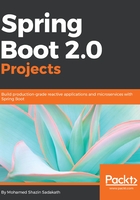
Supporting the Spring Framework ecosystem in Spring Boot
What made the Spring Boot application development framework stand out from other competing alternatives is the fact that it has a lot of supporting frameworks for easing development, with starter dependencies that cover industry-standard, enterprise-grade methodologies and tools such as Web MVC, JPA, MongoDB, Elasticsearch, Redis, and many more.
This makes Spring Boot a unique solution for day-to-day programming needs. By including a starter dependency, a Spring Boot application will have all the necessary dependencies and auto-configurations included in the application without any developer intervention.
This makes the life of a developer easy and enables us to focus on the business logic of the application instead of configurations and dependency management. At the time of writing, there are more than thirty of these starters available to be used in a Spring Boot application. The complete list can be found at https://github.com/spring-projects/spring-boot/tree/master/spring-boot-project/spring-boot-starters.
Spring Boot is a powerful framework as it has a very gradual learning curve and is built on the basis of the ability to write applications that just run with minimal effort. Having said that, Spring Boot should not be mistaken for a silver-bullet solution for all problems. In the areas of memory utilization, optimization, latency reduction, and many more, work may be needed, so developer commitment and effort are still required. But all in all, Spring Boot can be considered as a very good solution as it enables users to develop a minimum viable product (MVP) that is production-ready within maybe a couple of days or hours.